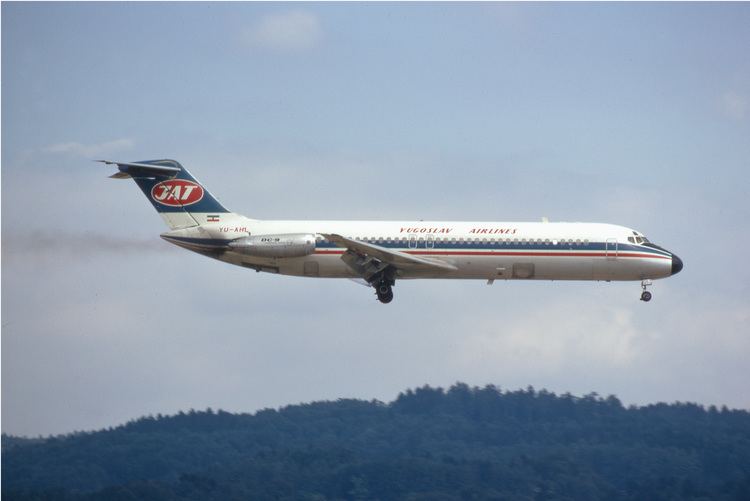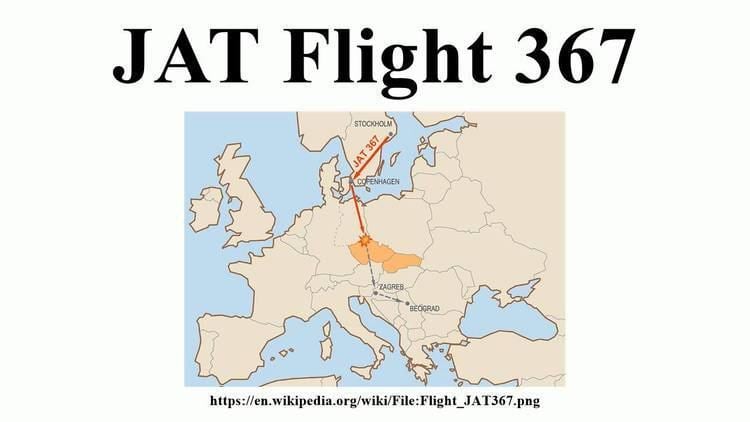Summary Bombing Crew 5 Injuries (non-fatal) 1 (Vesna Vulović) Number of deaths 27 Survivor 1 | Passengers 23 Fatalities 27 Date 26 January 1972 Operator Air Serbia Passenger count 23 | |
 | ||
Similar Cathay Pacific Flight 700, Sterling Airways Flight 296, Japan Airlines Flight 446, Japan Airlines Flight 471, Iberia Airlines Flight 602 | ||
Jat flight 367
JAT Yugoslav Airlines Flight 367 was a McDonnell Douglas DC-9-32 aircraft (registration YU-AHT) which exploded shortly after overflying NDB Hermsdorf, East Germany, while en route from Stockholm to Belgrade on 26 January 1972. The aircraft, piloted by captain Ludvik Razdrih, broke into two pieces and spun out of control, crashing near the village of Srbská Kamenice in Czechoslovakia (now the Czech Republic). Of the 28 on board, 27 were killed upon ground impact and one Serbian crew member, Vesna Vulović, survived.
Contents

Cause

The McDonnell Douglas DC-9-32 was destroyed after a bomb on board, placed by émigré Croatian terrorists (Ustashe), exploded during flight. The plane was bound for Serbia (then part of Yugoslavia) from Sweden. The homemade bomb had been placed in the forward cargo. Vesna Vulović was near the rear of the aircraft at the time of the explosion but this is disputed. A food cart pinned her to the back of the plane during her fall, acting as a seat belt, thus preventing her from being sucked out of the plane during de-compression or the ensuing fall. Some reports stated she was at the back when the explosion occurred, but she has said she was told that she was found in the middle section of the plane.

Vulović was in a coma for 27 days and was temporarily paralyzed from the waist down, but survived. She continued working for the airline, holding a desk job.
In popular culture

Vesna Vulović holds the official record in the Guinness Book of Records for the highest fall survived without a parachute. Vulović received the Guinness prize from Paul McCartney.

A major celebrity in the Socialist Federal Republic of Yugoslavia, Vesna Vulović was a frequent guest on major Yugoslav TV shows such as Maksovizija by Milovan Ilić Minimaks, up until the 1990s. Vulović attended annual commemorations at the crash site, until they were stopped in 2002. The daughter of the firefighter that saved her bears her name, as well as a local hotel called Pension Vesna in the Czech Republic, near the site of the crash.

The plane crash was a subject of MythBusters. Episode 37, "Escape Slide Parachute (Story of Vesna Vulović)" was devoted to her case. MythBusters concluded it was possible to survive the fall depending on how the wreckage someone was sitting in landed. Discovery Channel in the program Against all Odds also profiled Vulović's fall to earth.
Conspiracy theories
The officially stated cause of the crash was challenged occasionally over the years by conspiracy theories. For example, in 1997 the Czech periodical Letectví a kosmonautika reported that the plane was shot down by mistake by Czechoslovak air defenses.
Shootdown theory
The discussion about different aspects of the crash was reopened on 8 January 2009, when German news magazine Tagesschau featured a report by investigative journalists Peter Hornung and Pavel Theiner. Allegedly based on newly obtained documents mainly from the Czech Civil Aviation Authority, they concluded that it was "extremely likely" that the plane had been mistakenly shot down only a few hundred meters above the ground by a MiG fighter of the Czechoslovak Air Force, having been mistaken for an enemy aircraft while attempting a forced landing. All the evidence suggesting that the plane was destroyed at high altitude by explosives placed in a suitcase would be therefore forged by Czechoslovak secret police.
As evidence that the DC-9 had broken up at a lower altitude, the journalists cited eyewitnesses from Srbská Kamenice, who had seen the plane burning but still intact below the low-hanging clouds, and confirmation of a Serbian aviation expert (who had been present at the crash site) that the debris area had been much too small for a crash from high altitude; it also referred to sightings of a second plane. According to Hornung, flight 367 got into difficulties, "went into a steep descent and found itself over a sensitive military area", close to a nuclear weapons facility. However, Hornung himself stated that for his theory "there are only indications, no evidence".
Reactions
Vesna Vulović (who has no memory of the crash or the flight after boarding) referred to the claims that the plane attempted a forced landing or descended to such low altitude as a "nebulous nonsense". A representative of Guinness World Records stated that "it seems that at the time Guinness was duped by this swindle just like the rest of the media."
The Czech Civilian Aviation Authority dismissed the conspiracy theory as media speculation, that appears from time to time. Its spokeswoman added that Authority experts would not comment on them and that findings of the official investigation are being questioned mostly because of the media attractiveness of the story.
The Czech magazine Technet quoted a Czech army expert: "In case of violation of the air space, the incident would not be solved by anti-air missiles, but by fighter planes. Also it would not be possible to conceal such incident, as there would approximately 150–200 people knowing about the incident. They would not have any reason to not tell about incident today." A potential missile launch would be audible and especially visible for thousands of people long afterwards. He further claims that for the Yugoslavian plane, it was technically impossible to dive in a "state of emergency" from the proven flight level to the low altitude and place where it was allegedly shot down. He also states that the debris area wasn't "too small" but that the main parts were more than 1.5 km apart.
Additionally, the Czechoslovak Air Defense soldier who operated the radar that very day stated in a 2009 interview that any Czechoslovak jet fighters would be noticed by the West German Air Defense.
The main argument against such a theory is the flight data obtained from the black box, which provided the exact data about the time, speed, direction, acceleration and altitude of the plane at the moment of the explosion. Both black boxes were opened and analysed by the service companies in Amsterdam in the presence of experts from Czechoslovakia, Yugoslavia, and the Dutch Aviation Office (Raad voor de Luchtvaart).
